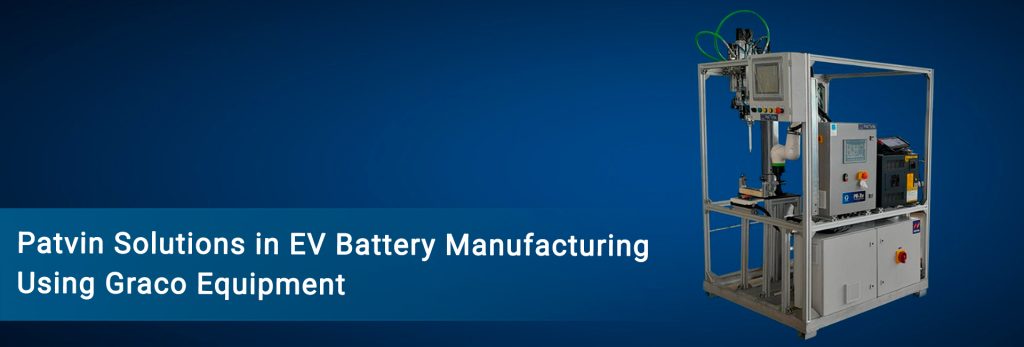Electrification is Transforming Transportation
Electric vehicles (EVs) is the biggest change since the internal combustion engine was invented. Lithium-ion batteries are central to this shift advancement. These batteries are widely used in electric cars due to their efficiency, long lifespan, lightweight design and environmental considerations.
Supporting Materials Make EVs Possible – Adhesives, Sealant, coatings & thermal interface materials are all important components of electrification are used to build & protect EV batteries & systems.
Patvin delivers customized EV battery manufacturing solutions—from cell bonding and foam encapsulation to gap filling, structural bonding, sealing, and fireproofing. We use Graco equipment to ensure precision, reliability, and top performance across every application.
EV Battery Assembly
Bonding, sealing & thermal applications
- MODULE ASSEMBLY
- PACK ASSEMBLY
If you’d like a step-by-step overview of how these stages come together, read our blog on EV Battery Assembly Process.
Cell To Carrier Bonding
Cylindrical cells are often bonded to a polycarbonate carrier during module assembly. This holds the cells stationary through the tab welding process and provides structural integrity to the module. A variety of adhesive chemistries can be used in this application, including UV and two-component acrylics. Rapid precision dispensing is critical to this application.
Fireproof Coating
The cover of the battery pack can be sprayed with a fireproof coating that not only protects against fire but also protects against corrosion. As the coating is applied, its thickness must be consistent over the complete cover with as little overspray as possible. It is therefore important to use equipment that can keep a constant and accurate spray pattern without overspray. Correctly handle these gap filler materials.
Cell To Cell And Cell To Frame Bonding
Inside prismatic or pouch module designs, cells are firmly bonded to each other to create cell stacks and to provide complete insulation and protection against vibration or movement. In many cases, modules are enclosed in a lightweight polycarbonate or acrylonitrile butadiene styrene (ABS) enclosure that is sealed closed. Frame Bonding Cells are bonded with the frames around them to protect against outside contaminants. The sealing surfaces are generally very small & require precise bead dispensing.
Module Encapsulation
Module encapsulation, often used in cylindrical cell modules, provides for increased shock and vibration performance and is used to help prevent thermal runaway or propagation events within the modules. These materials are generally two- component polyurethanes, silicones, or epoxies that have a foaming reaction to create a lightweight buffer between the cells. This challenging application requires the right equipment and expertise, as ratio, flow, and mixing energy are all critical variables.
Gap Filling
The performance of the battery is highly dependent on good thermal management. Thermal interface materials or gap fillers provide perfect thermal dissipation from the heated modules to the cooling circuits on the battery pack. These one and two component gap fillers are generally non-structural but are very viscous with highly abrasive fillers which contain ideal heat conducting characteristics. The application often requires high flow dispensing with robust pumping, precise metering and dispensing, where air gaps must be avoided for an optimal heat transfer.
Structural Adhesive
Structural bonding with one-component or two- component epoxies is done to bond aluminum or other materials within a battery pack. This not only contributes to the lightweight design but also offers extra strength and rigidity to the battery pack, which helps its crash durability over the lifetime of the battery. Given the important nature of this application, the right equipment is a must.
Pack Seal
The pack seal is critical to the longevity and safety of a battery pack. The seals are often designed to an IP68 standard, which means that the seal will protect against water intrusions as well as outside contaminants. A variety of sealants can be used and fall into two categories: cure-in-place gaskets (CIPG) and form-in-place gaskets (FIPG). CIPG gaskets are dispensed and allowed to cure before assembly, creating a compression gasket in the pack seal joint. Alternatively, an FIPG gasket is dispensed, assembled immediately, and allowed to cure over time. In either case, precise and repeatable dispensing equipment is required for this critical seal.
EV Batteries Solutions | |
Application | Key Benefits for the Customer |
Cell Bonding | a) Helps the cells maintain structural integrity |
Dielectric Coatings | a) Extremely thin protective layers |
Fireproofing | a) Protects the battery from extreme heat and corrosion |
Battery Encapsulation | a) Adds structural strength and rigidity to the battery pack |
Pack Seal | a) Protects against water intrusion, corrosion, and outside contaminants |
Structural Bonding | a) Helps make a battery light weight |
Thermal Management (GAP Filler) | a) Critical for maintaining battery performance and safety |
For a deeper look into why thermal control is so critical in EV batteries, explore our blog on The Role of Thermal Management Solutions in EV Battery Production.
At Patvin, we understand the challenges of EV battery assembly—from precise dispensing to ensuring long-term performance and safety. Using advanced Graco Equipment, our proven systems, deep industry expertise, and reliable support help you build better batteries, faster.
Explore our full range of EV battery manufacturing solutions and see how we can support your next project.
Choose Patvin for smart, efficient, and scalable solutions tailored to your EV project.
FAQ's
Gear meters give you a steady flow that is very accurate and does not have any pulses. They are ideal for applications where small flow changes can affect product quality or safety.
Changing the temperature of a fluid can make it thicker or thinner, which changes how it flows. Thus, a pump model should match your fluid type and temperature range.
Without fluid to lubricate the gears, running dry can harm the pump. Using a dry-run protection system or keeping the pump primed are the best options.


